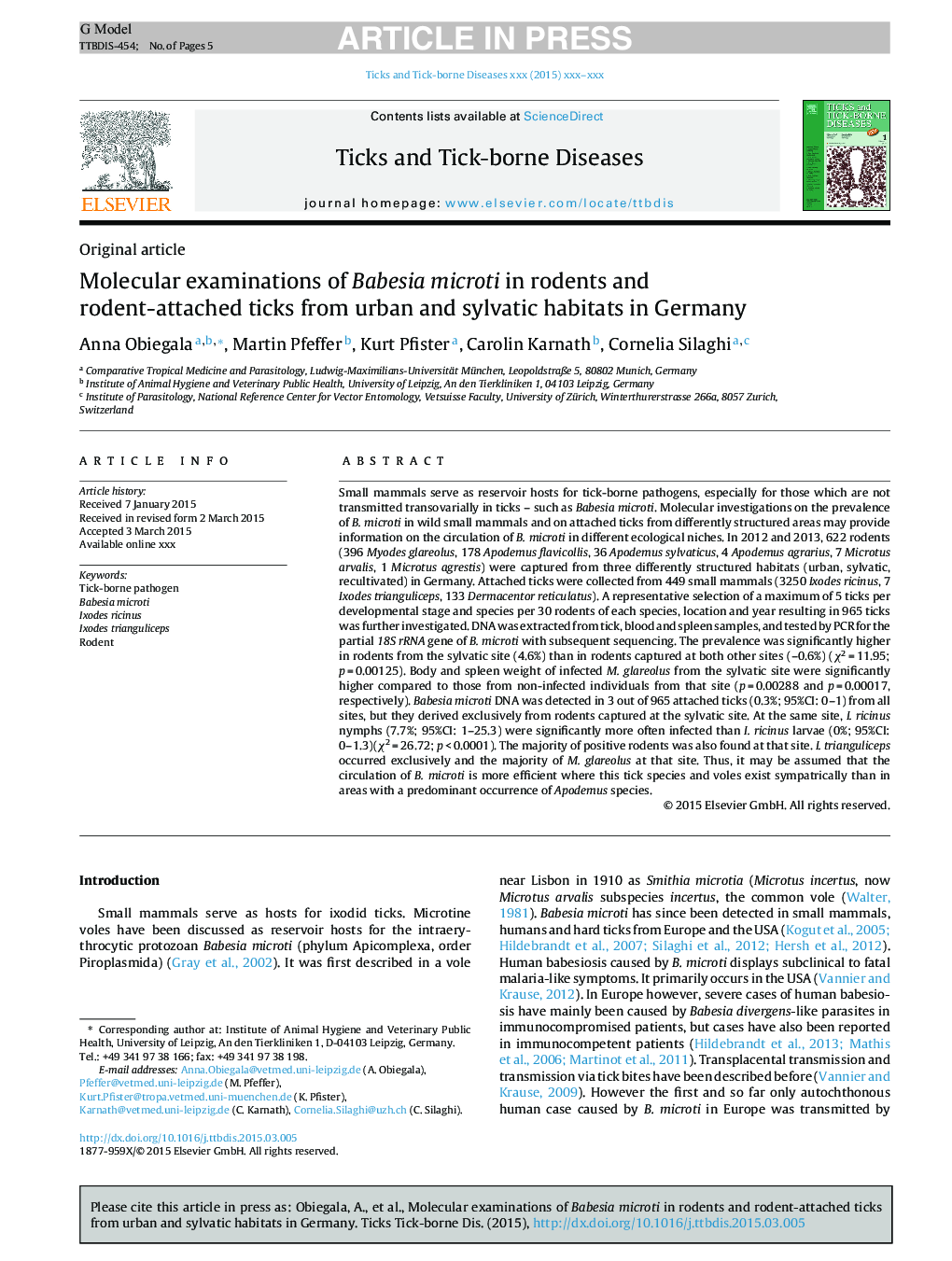| کد مقاله | کد نشریه | سال انتشار | مقاله انگلیسی | نسخه تمام متن |
|---|---|---|---|---|
| 5807298 | 1113122 | 2015 | 5 صفحه PDF | دانلود رایگان |
عنوان انگلیسی مقاله ISI
Molecular examinations of Babesia microti in rodents and rodent-attached ticks from urban and sylvatic habitats in Germany
ترجمه فارسی عنوان
معاینه های مولکولی میکروتیک بابسی در جوندگان و جوندگان متصل به جوندگان از زیستگاه های شهری و سیلوا در آلمان
دانلود مقاله + سفارش ترجمه
دانلود مقاله ISI انگلیسی
رایگان برای ایرانیان
کلمات کلیدی
موضوعات مرتبط
علوم زیستی و بیوفناوری
علوم کشاورزی و بیولوژیک
علوم دامی و جانورشناسی
چکیده انگلیسی
Small mammals serve as reservoir hosts for tick-borne pathogens, especially for those which are not transmitted transovarially in ticks - such as Babesia microti. Molecular investigations on the prevalence of B. microti in wild small mammals and on attached ticks from differently structured areas may provide information on the circulation of B. microti in different ecological niches. In 2012 and 2013, 622 rodents (396 Myodes glareolus, 178 Apodemus flavicollis, 36 Apodemus sylvaticus, 4 Apodemus agrarius, 7 Microtus arvalis, 1 Microtus agrestis) were captured from three differently structured habitats (urban, sylvatic, recultivated) in Germany. Attached ticks were collected from 449 small mammals (3250 Ixodes ricinus, 7 Ixodes trianguliceps, 133 Dermacentor reticulatus). A representative selection of a maximum of 5 ticks per developmental stage and species per 30 rodents of each species, location and year resulting in 965 ticks was further investigated. DNA was extracted from tick, blood and spleen samples, and tested by PCR for the partial 18S rRNA gene of B. microti with subsequent sequencing. The prevalence was significantly higher in rodents from the sylvatic site (4.6%) than in rodents captured at both other sites (-0.6%) (Ï2 = 11.95; p = 0.00125). Body and spleen weight of infected M. glareolus from the sylvatic site were significantly higher compared to those from non-infected individuals from that site (p = 0.00288 and p = 0.00017, respectively). Babesia microti DNA was detected in 3 out of 965 attached ticks (0.3%; 95%CI: 0-1) from all sites, but they derived exclusively from rodents captured at the sylvatic site. At the same site, I. ricinus nymphs (7.7%; 95%CI: 1-25.3) were significantly more often infected than I. ricinus larvae (0%; 95%CI: 0-1.3)(Ï2 = 26.72; p < 0.0001). The majority of positive rodents was also found at that site. I. trianguliceps occurred exclusively and the majority of M. glareolus at that site. Thus, it may be assumed that the circulation of B. microti is more efficient where this tick species and voles exist sympatrically than in areas with a predominant occurrence of Apodemus species.
ناشر
Database: Elsevier - ScienceDirect (ساینس دایرکت)
Journal: Ticks and Tick-borne Diseases - Volume 6, Issue 4, June 2015, Pages 445-449
Journal: Ticks and Tick-borne Diseases - Volume 6, Issue 4, June 2015, Pages 445-449
نویسندگان
Anna Obiegala, Martin Pfeffer, Kurt Pfister, Carolin Karnath, Cornelia Silaghi,
